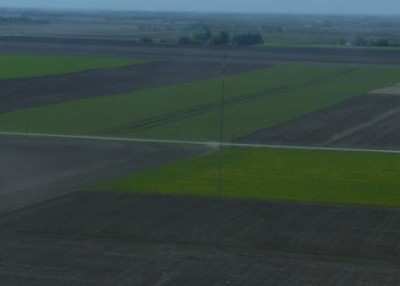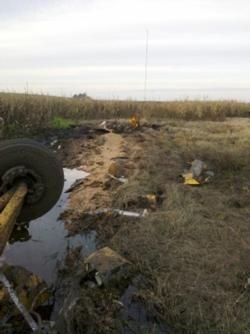Ag Pilot Fatally Injured In Collision With The Structure
A settlement was reached last week on the wrongful death action filed by the family of California agricultural aviator Steve Allen in the amount $6.7 million against a group of defendants representing tower manufacturing, wind energy, land-owning and farming interests for not marking or making aware the location of an unmarked meteorological evaluation tower (MET) to protect the pilot. The settlement establishes a standard of care as to the use of METs for wind prospecting in agricultural areas.

The case stems from a January 10, 2011, aviation fatality whereby Northern California agricultural pilot Steve Allen struck a MET resulting in his death. The MET had been erected in April 2009. The tower was an eight-inch galvanized, unmarked, unlit structure manufactured by NRG Systems Inc. It was installed by Echelon Environmental Energy and PDC Corporation, which had been hired by Renewable Resources Group, the agent and representative of ZKS Real Estate Partners and Delta Wetland Properties, to monitor wind levels to prospect for the potential to generate wind energy around the tower's location. At 60 meters (197 feet), the tower's height fell just short of the 200-foot threshold whereby FAA regulations would have required it to be marked in a more visible fashion to low flying aviators.
Allen had been hired by Bouldin Farming Company to spread winter wheat on one of the fields in Webb Tract Island, located in California's Contra Costa County. The defendants were mindful that the FAA had a requirement of marking and lighting such a tower if it exceeded 200 feet. By attempting to erect a tower literally inches under 200 feet, they believed the tower was not required to be evaluated or registered with the FAA, nor compliant with the requirements that it be marked and made visible if over 200 feet. The defendants, through their insurance carriers, have contributed to settle this matter for the sum of $6.7 million.
On the day of the fatal incident, Allen was never made aware of the existence of the tower by Bouldin Farming Company, and from eyewitness accounts, it was clear he never saw it before he struck it. Allen's death isn't the first time an agricultural aviator has had a fatal collision with an unmarked and unlit MET during daytime operations. An analysis of FAA and NTSB accident data by the National Agricultural Aviation Association (NAAA) shows that 10 fatal agricultural aircraft accidents in the past 14 years (2000–2013) involved collisions with towers—including three with unmarked MET towers. METs in the last 10 years have become much more popular and utilized as investors look for locations to install wind farms. These same towers have been the subject of NTSB advisories pointing out the dangers they pose to agricultural aviators.
Steve Allen is survived by his wife of more than 20 years, Karen Allen, and his two adult daughters, Gail and Angie. Allen, who had logged more than 26,000 accident-free hours in his agricultural aircraft, was well known for having a stellar reputation for safety and ability, according to local farmers who had used his services and were deposed in the case. "He set the gold standard for aerial application," said Brent Tadman, farms operation manager for M&T Staten.

"Steve Allen was a consummate professional and our go-to agricultural aviator," Mark Boyd, farms operation manager for Hastings Island, said. "His death was a tragic and unacceptable loss that we all felt."
The National Agricultural Aviation Association and its sister organization, the National Agricultural Aviation Research and Education Foundation (NAAREF), were in consultation with Mrs. Allen providing information and expert witness suggestions. A key safety mission for NAAA has been urging state and federal government action to require improved marking of towers below 200 feet. This involvement led to the FAA amending "Advisory Circular (AC) 70/7460-1K – Obstruction Marking and Lighting Document Information" to include MET marking guidance after the Allen accident. NAAA was also successful in urging Congress to pass legislation requiring the FAA to conduct a study on the feasibility of developing a database storing the locations of towers under 200 feet. NAAA has also developed a number of tools to educate the tower and agricultural industry, along with the public, about the dangers unmarked obstacles pose to pilots of low-flying aircraft.
"Agricultural aviators deal with hazards every day they are in the air, and they need to know of obstacles and hazards. We believe this case establishes a standard of care in the community, and wind energy and agricultural businesses are now on notice of this standard of care that is required of them and the potential exposure they face, should they not properly and adequately mark these towers," said NAAREF President Rod Thomas, owner of Thomas Helicopters in Gooding, Idaho. Thomas also testified in this action.
NAAA Executive Director Andrew Moore stated, "We believe that this case, and the result, sets a clear standard of care in the agricultural and MET community. Now those individuals who lease land for the use of METs and wind energy investors have to recognize that the standard for them is to mark these towers and obstructions so that agricultural aviators will be able to be aware of their presence and avoid them accordingly. Strobe lighting, painting and other visible markings along with databases showing exact geographical locations of these towers are some of the proper safety standards to use to protect agricultural aviators from low-level towers."
(Top image provided by the FAA shows a MET tower. Bottom image provided by the NTSB of an accident involving a MET tower)
 ANN's Daily Aero-Term (04.26.24): DETRESFA (Distress Phrase)
ANN's Daily Aero-Term (04.26.24): DETRESFA (Distress Phrase) ANN's Daily Aero-Linx (04.26.24)
ANN's Daily Aero-Linx (04.26.24) Airborne 04.22.24: Rotor X Worsens, Airport Fees 4 FNB?, USMC Drone Pilot
Airborne 04.22.24: Rotor X Worsens, Airport Fees 4 FNB?, USMC Drone Pilot Airborne 04.24.24: INTEGRAL E, Elixir USA, M700 RVSM
Airborne 04.24.24: INTEGRAL E, Elixir USA, M700 RVSM Airborne-NextGen 04.23.24: UAVOS UVH 170, magni650 Engine, World eVTOL Directory
Airborne-NextGen 04.23.24: UAVOS UVH 170, magni650 Engine, World eVTOL Directory




